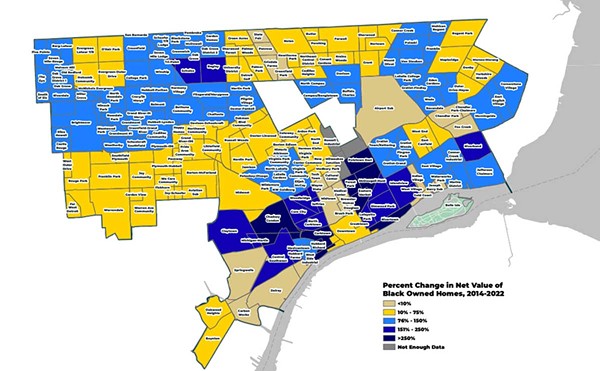1410 Gratiot Ave., Detroit; 313-744-6505; innerstategallery.com
If you want some wacky, cool, limited-edition artwork, Inner State is where it's at. Bringing in world-class artists from around the globe, Inner State Gallery shows are some of the best in the city. The eclectic crowd the gallery draws is pretty sweet, as well. The show that's just opened, for instance, Luke Chueh's "Damaged Goods," is filled with wry and crafty postmodern pop art.
April marks the 60th anniversary of the final DSR streetcar to run down a Detroit thoroughfare. There were many reasons the streetcar largely disappeared from U.S. cities: inflation, labor costs, the automobile, popular attitudes, with an able assist from automaker propaganda. But streetcar systems weren't scrapped everywhere. Many European cities did not get rid of their "tram" systems, and U.S. cities that didn't pave over their rails never fell quite as far as Detroit did in the 1970s and 1980s. Our urban rail system was the circulatory system for the city. To remove it and to expect private cars to do the same quality of work seems to have contributed to our city's decline. Perhaps our starter system downtown, scheduled to open in 2017, will be built into a real rapid transit system. We could use it again.
We tracked down Hamtramck's power rangers earlier this year and met William Berry and Joseph Brooks, both 25, of Hamtramck. They're huge fans of science fiction, martial arts, comics, and dressing up. And almost as soon as they go out in public in their getups, they're scoring high-fives and selfies with anybody within eyeshot. "We've met so many people that have had the same love and affection for the Power Rangers," Brooks says. "We've made so many friends along the way. We've run into so many people who love Power Rangers just as much as we do." Is there any better place for this sort of fun than "The City of Friendship"?
When Dmytro Szylak retired from General Motors in 1992, he began installing whirligigs and fanciful sculptures in his backyard. Over the years, they grew and became a massive, colorful attraction he called "Hamtramck Disneyland." But since Szylak died at 92 in May 2015, the future of the artwork has been in a sort of limbo. A group of Hamtramck residents, including Hamtramck Mayor Karen Majewski, writer Walter Wasacz, Chris Schneider, and others, had been working with the new property owner to try to work out a plan whereby the mammoth artwork can be preserved. Those efforts haven't paid off yet, but they continue, and may even involved heavy-hitting nonprofits dedicated to preserving folk art. Anybody interested in helping should see the SAVE Hamtramck Disneyland page on Facebook.
This year, we took a warts-and-all look at Hamtramck's Muslim-majority city council. With right-wing bloggers and news media in high dudgeon over the election results, we talked to the locals, the mayor, and council members who'd been bombarded by phone calls from around the world. What did we find? A small-town city council much like other city councils, full of bickering, dissent, and not-ready-for-prime-time politics. But everybody involved seemed to be serious about leaving religion out of government, and hopeful about the little city's future. In a category built for one, they're still good enough to merit mention.
It has been a long road down for disgraced former Detroit City Councilman Charles Pugh. We initially liked Pugh when he ran for council. We took him at his word when he promised to usher in a new era of civility and professionalism on the council. But power seemed to bring out a petty and confrontational streak in him. Critics charged that, as council president, Pugh was responsible for violating open meetings laws, and he seemed eager to declare war over tiny slights any seasoned public official would brush off. In the end, he was undone by charges he offered to pay a Detroit Public Schools student intern for a sex tape. Pugh was hit with a $250,000 judgment, which will take some time to work off in his capacity as a restaurant manager in New York City. Finally, last year, his pre-recorded deposition over the teen sex scandal, Pugh offered a mealy mouthed apology: "I am embarrassed, and I am regretful for what happened." With good reason: Pugh has given homophobes a potent example of somebody who let his sexuality get in the way of professional conduct in dealing with children.
Just a few years after community anger had prompted the removal of a massive pile of "pet coke" from the riverfront near Southwest Detroit, a new pile began to appear. But the people responsible had a soothing argument: It's not pet coke — it's "coke breeze." Why should that make you feel better? Because a lawyer for the company storing it says coke breeze is entirely different than pet coke. Sure, there are a few passing similarities to what happened a few years ago, such as the way the dust blows off the piles into people's homes. But it's really, totally different. Why? Because it has a different name. Don't you feel better already?
The story was so bizarre that it wouldn't have been believed without an audio recording confirming it: Knowing that his heterosexual affair with fellow Tea Party legislator Cindy Gamrat was bound to be revealed, homophobic, holy-rolling state Rep. Todd Courser hatched a wild scheme to circulate an email alleging that he was a bisexual cruiser who was spotted having gay sex behind a Lansing bar. He tried to convince an aide to help move the ruse forward, believing that his God-fearing followers would surely be pleased to learn that it was all a lie, and that all Courser was doing was diddling fellow Cindy Gamrat. (Makes sense, huh?) It became a glorious farce that ended with two antigay politicians' careers going down in gorgeous, rainbow-colored flames.
The image has by now become iconic: a 1,500-pound section of cinderblock and concrete from the Packard Plant depicting a child with a paintbrush next to the words: "I remember when all this was trees." When the 555 Gallery crew hauled it out of the hulking building in 2010, they initially claimed they hoped to preserve it. Turns out the street art world frowns on people taking possession of street art, especially if they want to sell it. Some experts said the piece could sell for as much as $1 million. The tony Los Angeles auction house putting it on the block said $400,000. In the end, after all the controversy, the section of wall sold for less than $140,000, and the gallery pocketed even less.
Residents of Hamtramck have faced some unusually bumpy roads last year. Reports said a contracting snafu meant the city had to discontinue the filling of potholes. That left Hamtramck in a lurch, until the Hamtramck Guerrilla Road Crew came onto the scene. With seed money of $120, and a willing group of a half-dozen volunteers, the group started filling the holes in July, working with the city government so no toes were stepped on. The unusual turn of events lit up news media across the region (and libertarian bloggers across the country).






